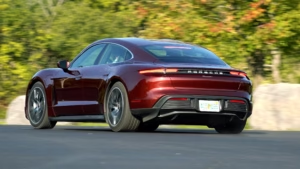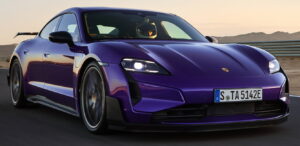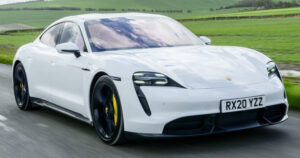Porsche Taycan prices finally stabilize – Is now the right time to buy?
1. Is the Porsche Taycan finally hitting bottom?
2. The downward spiral and where it stopped
3. A broader recovery across the lineup
4. What about the Cross Turismos?
5. Should You buy a Taycan now?
6. Conclusion
Is the Porsche Taycan finally hitting bottom?
Since its much-hyped debut, the Porsche Taycan has become a symbol of the electric vehicle market’s growing pains. Once celebrated as the EV to beat, its rapid depreciation has been equally dramatic. Over the past two years, Taycan prices have dropped by as much as 50%, with high-spec models losing more than €93,000 in value.
This price freefall made headlines across nearly every major automotive platform. Video after video dissected the Taycan’s downfall—until viewers were tired of hearing about it. But there’s good news at last: signs suggest the Taycan market may finally be stabilizing.
The downward spiral and where it stopped
The steepest losses occurred between mid-2022 and the end of 2023. For example, Turbo and Turbo S models dropped by 42.9% and 41.3% respectively, translating to about €82,600 and €102,000 in value loss. While luxury vehicles are known to depreciate quickly, this level of decline was unprecedented—even compared to models like the Panamera.
But 2024 brought a change. Over the past year, the depreciation rates flattened significantly: 10% for the Turbo and 10.5% for the Turbo S. Current average prices sit around €103,000 for a Turbo S and €82,800 for a Turbo. This recovery is most evident in older, higher-mileage Taycans—those with 10,000 miles or more.
Inventory data backs this up. Cars are staying on the market for shorter periods, and the average discount on unsold Turbo S models shrank from 9% in May 2023 to 3% now. The market, while still adjusting, is no longer in freefall.
A broader recovery across the lineup
The flattening trend isn’t limited to top-tier models. Lower trims like the GTS and S variants show similar behavior. For instance, the GTS lost 11.4% last year, comparable to the Turbo S. Interestingly, GTS models now fetch similar prices to the Turbo S, despite the latter’s higher original price—largely because GTS cars are newer and have half the mileage.
Base and S Taycans saw sharp declines between May 2022 and November 2023—30% for base models and 35% for S variants. But again, 2024 brought stability, with recent depreciation of 16.8% and 16.4% (around €10,700 and €11,500, respectively). The price gap between these two has also narrowed: in 2022, the S commanded a 22.5% premium. Today, it’s down to just 11%, with average prices of €57,900 for the S and €52,100 for the base.
Much of this stabilization is happening in model years 2020–2022, especially for cars with over 13,000 miles. Cars from 2023 and 2024 haven’t yet shown similar patterns—likely due to being newer and still under warranty.
What about the Cross Turismos?
Many enthusiasts have asked how the Cross Turismo models compare to the standard Taycan sedan. While they differ in price, the depreciation trends are quite similar. The base Cross Turismo lost 16.1%, and the S version dropped 20.1% over the past year.
However, data for the S variant is less reliable due to limited availability—only 15 to 20 cars are typically on the market. The base model, with 30 to 50 listings, provides a more trustworthy picture. Overall, there’s no significant resale advantage to choosing between sedan and Cross Turismo versions.
As for Turbo Cross Turismos, they are extremely rare (with just 3 to 15 cars on sale at a time), making solid conclusions difficult.
Should You buy a Taycan now?
So, with prices stabilizing, is now a good time to buy? It depends on what kind of buyer you are.
On one hand, you’d be buying after the worst of the crash, especially if you choose an older, higher-mileage model with flattening depreciation. On the other hand, depreciation remains high compared to the average market.
When compared to other fast-depreciating luxury models—like the Panamera (12%) or AMG GT (16%)—the Taycan now sits in similar territory, with an average annual depreciation rate of 13%. Turbo variants are holding value better, while base and S models still lag behind.
Another consideration is warranty coverage. The standard Porsche warranty lasts 4 years or 80,000 km, excluding the battery. The battery is covered for 8 years or 160,000 km, but the warranty only activates if the battery’s capacity falls below 70%. Extended battery warranties are rare, so if you’re eyeing a 2020 model, it’s likely nearing the end of its coverage—and an extended plan may be worth considering.
Conclusion
After a dramatic market crash, the Porsche Taycan is finally stabilizing. Prices are no longer falling at the breakneck pace we saw in 2023, and depreciation is now more in line with luxury car norms.
But buyers should still be cautious. While the worst is likely behind us, depreciation remains significant—especially for newer cars. If you’re value-conscious and risk-averse, an older Taycan (perhaps a Turbo or GTS) with a relatively flat depreciation curve might offer the best balance between cost, performance, and risk.
Buying a new model protects you from battery concerns—but comes with a higher upfront cost and faster depreciation. Perhaps the smartest strategy lies in short-term ownership of a Taycan that’s already weathered the worst of the storm.
Inspired by the analysis of our friend @fourwheeltrader. Make sure you check his other videos https://www.youtube.com/@fourwheeltrader/featured.
Are you already a proud owner of a Porsche Taycan? If so, check out our selection of parts for this car at the following link:
https://octoclassic.com/product-category/porsche
Photos sources: electrive.net, Express & Star, porsche.com, highmotor.com











